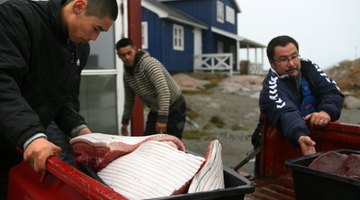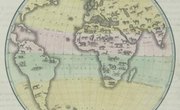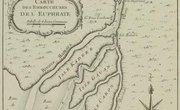The Aleut and Inuit peoples are indigenous cultures native to the far north of North America, Greenland and eastern Eurasia. Although the two cultures have a number of similarities, speak related languages and inhabit environments which are similar in some ways, there are a number of significant differences between them as well.
Inuit Culture
The Inuit culture is spread over a wide geographical area, ranging from Siberia to Greenland. The Inuit primarily live within the Arctic circle. Inuit speak several related dialects. An Inuit language, Inuktitut, is one of Canada's official languages. Traditional Inuit culture was largely based on hunting and fishing, and some Inuit continue these trades. Traditional Inuit religion is largely animist. The world is populated by spirits and supernatural forces, with shamans interceding between the community and these beings.
Aleut Culture
The Aleut people are the indigenous inhabitants of the Aleutian Islands in Alaska. Aleut populations are also found in islands off the coast of Russia's Kamchatka Peninsula. Traditional Aleut communities supported themselves by hunting and fishing. The Aleutian Islands are rocky and unsuitable for agriculture, making the sea the main source of food and materials. The Aleut language consists of three related dialects, but English and Russian are also commonly spoken. Piercings and tattoos are a common form of body decoration for the Aleut.
Differences in Region and Population
Although both the Aleut and Inuit peoples inhabit northern environments, particularly coastal environments, the Aleutian Islands are subarctic, while most Inuit populations are found within the Arctic circle . Inuit communities are distributed over a much wider geographical range, from northern Alaska and Siberia as far east as western Greenland. The Inuit population is significantly greater than the Aleut population. Exact population numbers are difficult to obtain, but there are approximately 2,000 Aleut today and over 100,000 Inuit.
Differences in Language and Culture
Aleut, also called Unangan, is distantly related to the Inuit languages. Both are part of the Eskimo-Aleut language family. However, they are very different, and a speaker of Inuit dialect would not be able to understand a speaker of Unangan. Culturally, both groups have traditional cultures reliant on hunting and fishing in an extremely cold environment. However, these traditional cultures vary in important details. For instance, traditional Inuit shelters include tents and the iglu, a shelter built from snow. Traditional Aleut houses are built from an underground chamber covered by a log roof.
Related Articles
References
Writer Bio
Dr James Holloway has been writing about games, geek culture and whisky since 1995. A former editor of "Archaeological Review from Cambridge," he has also written for Fortean Times, Fantasy Flight Games and The Unspeakable Oath. A graduate of Cambridge University, Holloway runs the blog Gonzo History Gaming.











